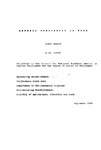Arsenic Speciation in Food
| dc.contributor.author | Branch, Simon | |
| dc.contributor.other | School of Geography, Earth and Environmental Sciences | en_US |
| dc.date.accessioned | 2013-02-08T09:28:51Z | |
| dc.date.available | 2013-02-08T09:28:51Z | |
| dc.date.issued | 1990 | |
| dc.identifier | N/A | en_US |
| dc.identifier.uri | http://hdl.handle.net/10026.1/1271 | |
| dc.description | Merged with duplicate record 10026.1/2138 on 03.04.2017 by CS (TIS) | |
| dc.description.abstract |
A high performance liquid chromatography-inductively coupled plasma-mass spectrometry (HPLC-ICP-MS) method has been developed for the separation and quantification of ~g kg-1 levels of arsenobetaine, monomethylarsonic acid (MMAA), dimethylarsinic acid (DMAA) , arsenite and arsenate. Using this coupling, arsenic species in fruit and vegetables grown on soils containing up to 1.4% w\w arsenic have been surveyed and DMAA, MMAA, arsenite and arsenate identified in the plants. Although extraction efficiencies were poor, typically 10%, total arsenic determinations demonstrated that arsenic uptake by the plants was low, with the highest arsenic level being 60-70 mg kg-1 dry weight in unpeeled potato. Provided the plants are washed thoroughly they pose no dietary risk. Using the same HPLC-ICP-MS coupling non-toxic arsenobetaine was identified as the major arsenic species in cod, dab, haddock, lemon sole, mackerel, plaice and whiting. Levels ranged between 1.0 mg kg-1 dry weight in the mackerel, to 187 mg kg-1 in the plaice. Mackerel also contained DMAA and possibly a lipid bound arsenic species. No degradation of arsenobetaine to more toxic species was observed when an enzymatic digestion procedure, based on the action of trypsin, was applied to fish except in the case of one of the plaice specimens for which DMAA was characterised in the digest at the mg kg-1 level. Ten volunteers participated in a dietary trial in which they were given set conventional meals. The main source of arsenic was fish and the predominant species was arsenobetaine. All of the arsenic, as arsenobetaine, was excreted in the urine within 72 hours of consumption. Urinary levels of MMAA, DMAA and inorganic arsenic were all below 10 µg. For total arsenic determination in the urine nitrogen introduction ICP-MS was used to overcome the polyatomic ion 40Ar 35Cl+. This method gave good agreement between observed and certified values for a range of reference materials. | en_US |
| dc.description.sponsorship | Ministry of Agriculture, Fisheries and Food | en_US |
| dc.language.iso | en | en_US |
| dc.publisher | University of Plymouth | en_US |
| dc.title | Arsenic Speciation in Food | en_US |
| dc.type | Thesis | |
| plymouth.version | Full version | en_US |
| dc.identifier.doi | http://dx.doi.org/10.24382/4741 | |
| dc.identifier.doi | http://dx.doi.org/10.24382/4741 |
Files in this item
This item appears in the following Collection(s)
-
01 Research Theses Main Collection
Research Theses Main


